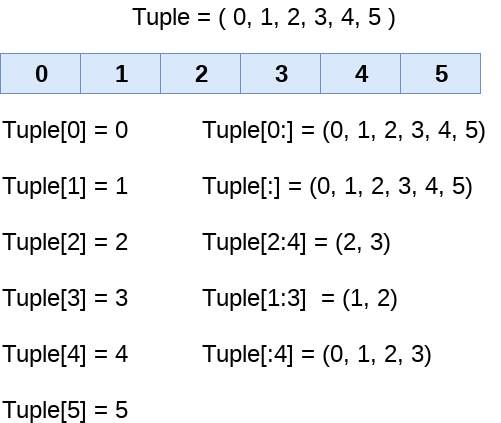- Python tuple()(1)
- Python Tuple(1)
- c++ tuple - C++ (1)
- c# tuple - C# (1)
- Python | tuple函数(1)
- Python | tuple函数
- c# tuple - C# 代码示例
- c++ tuple - C++ 代码示例
- python中的set和tuple(1)
- python代码示例中的set和tuple
- Python元组Tuple(1)
- Python元组Tuple
- 如何在C#中创建1-Tuple或Singleton Tuple?
- 如何在C#中创建1-Tuple或Singleton Tuple?(1)
- c# list tuple - C# (1)
- 函数式编程-Tuple
- 函数式编程-Tuple(1)
- 将 Set 转换为 Tuple 并将 Tuple 转换为 Set 的Python程序(1)
- 将 Set 转换为 Tuple 并将 Tuple 转换为 Set 的Python程序
- F# tuple 获取项目 - C# (1)
- c# list tuple - C# 代码示例
- ValueError: tuple.index(x): x not in tuple (1)
- F# tuple 获取项目 - C# 代码示例
- ValueError: tuple.index(x): x not in tuple - 任何代码示例
- python tuple to dict - Python (1)
- python drop in tuple - Python (1)
- python tuple to dict - Python 代码示例
- python drop in tuple - Python 代码示例
- 解压 c# tuple - C# (1)
📅 最后修改于: 2020-10-24 09:09:10 🧑 作者: Mango
Python Tuple(元组)
Python Tuple用于存储不可变的Python对象的序列。元组与列表相似,因为可以更改存储在列表中的项目的值,而元组是不可变的,并且不能更改存储在元组中的项目的值。
创建一个元组
元组可以写成用小括号()括起来的逗号分隔(,)值的集合。括号是可选的,但是使用是一种很好的做法。元组可以定义如下。
T1 = (101, "Peter", 22)
T2 = ("Apple", "Banana", "Orange")
T3 = 10,20,30,40,50
print(type(T1))
print(type(T2))
print(type(T3))
输出:
注意:不使用括号创建的元组也称为元组包装。
可以如下创建一个空的元组。
用单个元素创建元组稍有不同。我们需要在元素后面加上逗号以声明元组。
tup1 = ("JavaTpoint")
print(type(tup1))
#Creating a tuple with single element
tup2 = ("JavaTpoint",)
print(type(tup2))
输出:
元组的索引方式与列表相同。元组中的项目可以通过使用其特定的索引值进行访问。
考虑下面的元组示例:
示例-1
tuple1 = (10, 20, 30, 40, 50, 60)
print(tuple1)
count = 0
for i in tuple1:
print("tuple1[%d] = %d"%(count, i))
count = count+1
输出:
(10, 20, 30, 40, 50, 60)
tuple1[0] = 10
tuple1[1] = 20
tuple1[2] = 30
tuple1[3] = 40
tuple1[4] = 50
tuple1[5] = 60
示例-2
tuple1 = tuple(input("Enter the tuple elements ..."))
print(tuple1)
count = 0
for i in tuple1:
print("tuple1[%d] = %s"%(count, i))
count = count+1
输出:
Enter the tuple elements ...123456
('1', '2', '3', '4', '5', '6')
tuple1[0] = 1
tuple1[1] = 2
tuple1[2] = 3
tuple1[3] = 4
tuple1[4] = 5
tuple1[5] = 6
元组的索引方式与列表相同。元组中的项目可以通过使用其特定的索引值进行访问。
在本教程的这一部分中,我们将看到元组的所有这些方面。
元组索引和切片
元组中的索引和切片类似于列表。元组中的索引从0开始,到length(tuple)-1。
可以使用index []运算符访问元组中的项目。 Python还允许我们使用冒号运算符访问元组中的多个项目。
考虑下图以了解详细的索引编制和切片。

考虑以下示例:
tup = (1,2,3,4,5,6,7)
print(tup[0])
print(tup[1])
print(tup[2])
# It will give the IndexError
print(tup[8])
输出:
1
2
3
tuple index out of range
在上面的代码中,元组有7个元素,表示0到6。我们试图访问在元组之外引发了IndexError的元素。
tuple = (1,2,3,4,5,6,7)
#element 1 to end
print(tuple[1:])
#element 0 to 3 element
print(tuple[:4])
#element 1 to 4 element
print(tuple[1:5])
# element 0 to 6 and take step of 2
print(tuple[0:6:2])
输出:
(2, 3, 4, 5, 6, 7)
(1, 2, 3, 4)
(1, 2, 3, 4)
(1, 3, 5)
负索引
元组元素也可以通过使用负索引来访问。索引-1表示最右边的元素,索引-2表示倒数第二个元素,依此类推。
使用负索引从左到右遍历元素。考虑以下示例:
tuple1 = (1, 2, 3, 4, 5)
print(tuple1[-1])
print(tuple1[-4])
print(tuple1[-3:-1])
print(tuple1[:-1])
print(tuple1[-2:])
输出:
5
2
(3, 4)
(1, 2, 3, 4)
(4, 5)
删除元组
与列表不同,由于元组是不可变的,因此不能使用del关键字删除元组项目。要删除整个元组,可以在元组名称中使用del关键字。
考虑以下示例。
tuple1 = (1, 2, 3, 4, 5, 6)
print(tuple1)
del tuple1[0]
print(tuple1)
del tuple1
print(tuple1)
输出:
(1, 2, 3, 4, 5, 6)
Traceback (most recent call last):
File "tuple.py", line 4, in
print(tuple1)
NameError: name 'tuple1' is not defined
元组基本操作
串联(+),重复(*),成员资格(in)等运算运算符的工作方式与使用列表相同。请考虑下表以获取更多详细信息。
假设声明了元组t =(1、2、3、4、5)和元组t1 =(6、7、8、9)。
| Operator | Description | Example |
|---|---|---|
| Repetition | The repetition operator enables the tuple elements to be repeated multiple times. |
T1*2 = (1, 2, 3, 4, 5, 1, 2, 3, 4, 5) |
| Concatenation | It concatenates the tuple mentioned on either side of the operator. |
T1+T2 = (1, 2, 3, 4, 5, 6, 7, 8, 9) |
| Membership | It returns true if a particular item exists in the tuple otherwise false |
print (2 in T1) prints True. |
| Iteration | The for loop is used to iterate over the tuple elements. |
for i in T1:
print(i)
Output 1 2 3 4 5 |
| Length | It is used to get the length of the tuple. |
len(T1) = 5 |
Python Tuple内置函数
| SN | Function | Description |
|---|---|---|
| 1 | cmp(tuple1, tuple2) | It compares two tuples and returns true if tuple1 is greater than tuple2 otherwise false. |
| 2 | len(tuple) | It calculates the length of the tuple. |
| 3 | max(tuple) | It returns the maximum element of the tuple |
| 4 | min(tuple) | It returns the minimum element of the tuple. |
| 5 | tuple(seq) | It converts the specified sequence to the tuple. |
在哪里使用元组?
在以下情况下,使用元组代替列表。
1.使用元组而不是列表可以使我们清楚地知道元组数据是恒定的,不能更改。
2.元组可以模拟不带键的字典。考虑以下嵌套结构,可以将其用作字典。
[(101, "John", 22), (102, "Mike", 28), (103, "Dustin", 30)]
列表与元组
| SN | List | Tuple |
|---|---|---|
| 1 | The literal syntax of list is shown by the []. | The literal syntax of the tuple is shown by the (). |
| 2 | The List is mutable. | The tuple is immutable. |
| 3 | The List has the a variable length. | The tuple has the fixed length. |
| 4 | The list provides more functionality than a tuple. | The tuple provides less functionality than the list. |
| 5 | The list is used in the scenario in which we need to store the simple collections with no constraints where the value of the items can be changed. | The tuple is used in the cases where we need to store the read-only collections i.e., the value of the items cannot be changed. It can be used as the key inside the dictionary. |
| 6 | The lists are less memory efficient than a tuple. | The tuples are more memory efficient because of its immutability. |